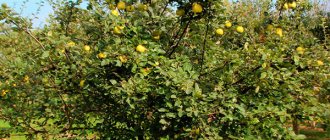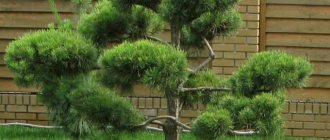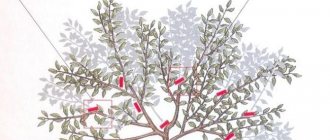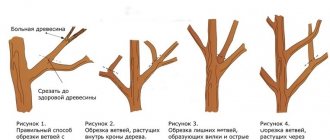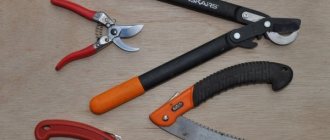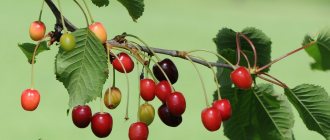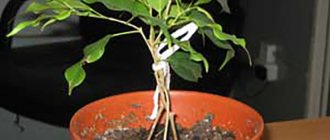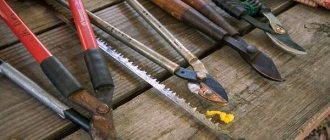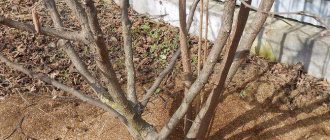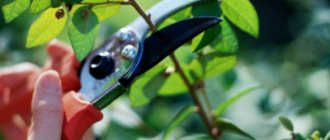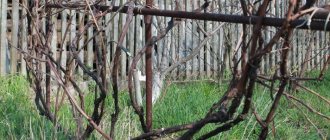Formation of cherries using the Vogel system (T. Vogel)
In the year of planting - Planting is carried out with unbranched annuals according to a pattern of 3x3 m on weak-growing rootstocks, 4.5x3.5 on vigorous-growing ones. Strong annuals are pruned to a height of 90-110cm. Weak ones - those with a height of 70-80 cm are left as is. At the very end of the guide, 2 buds are left, and below 5-6 are plucked out. In summer, 3-4 strong horizontal shoots appear (we use clothespins to make the branch angle close to 90 degrees.) 2 leader shoots develop at the top, one stronger one is removed in May-June.
The second year - the central leader is cut at a distance of 80 cm from the upper side branch. Again leaving 2 buds at the top and breaking out 3-5 buds underneath. We bend the young shoots on the leader again into the horizon with clothespins.
The third year - we repeat the same techniques again. At the end of the year we get a well-formed crown with 1 conductor and symmetrical side branches.
The fourth and subsequent years - perform renewal pruning after harvesting. Cutting out 3 year old thick branches “on a twig”. In the upper part of the tree, shoots that compete with the conductor are removed - primarily those that exceed half the thickness of the conductor itself. When the conductor reaches the required height, it is cut out by transferring it to a weak side branch.
Types of pruning
Summer treatment will help relieve you of unnecessary worries during the winter. It will be possible to limit yourself to preventive pruning of the tree, removing damaged branches. To achieve results from pruning, it is necessary to carry it out according to a special scheme in combination with proper feeding and timely watering, which will enrich the tree and facilitate the growth process.
Hygienic
Such pruning should be done when the tree is aging, when the quantity and quality of fruits decrease, the taste deteriorates, and diseases increasingly overtake the plant.
Hygienic pruning is carried out to rejuvenate the tree. All branches are shortened to the length of a two-year-old plant after fruiting.
It consists of a significant shortening of all branches to the length of a two-year-old plant and is carried out after fruiting.
Restorative
Pruning also has a restorative function and can help during the period when the fruits are rotting at the moment of ripening. If watering does not help, then resort to urgent pruning. Remove weak, broken shoots, branches on which these fruits grow.
This procedure will help save the remains of the crop and prevent the problem from occurring next year.
To slow growth
If pruning is not done in time, the cherry tree will grow upward uncontrollably. Forming a cone-shaped tree will help to avoid this effect. This will help eliminate the obstruction of sunlight reaching all branches and help balance the amount of moisture coming from the external environment.
On the left is the tree before pruning, on the right is after
It is best to introduce trees to pruning from a young age. Then it is easier to control its growth and easier to give the desired shape.
To maintain the growth of cherries, it is recommended to move the central conductor to the side branches.
Formation of cherries and sour cherries using the “Spanish bush” system
All gardeners, without exception, know that cherries, as well as cherry-cherry hybrids - dukes, have a tendency to grow wildly and, first of all, in height. If a seedling is left without proper pruning, it forms a sparse, elongated pyramidal and unproductive crown, reaching a height of about 5-6 meters in the first ten years. As a result, we get a high crown that is very inconvenient for harvesting. But this problem has long been resolved in the system of tree formation using the “Spanish Bush” method.
This system was first introduced into industrial plantings of cherries in Spain. The structure of the crown of the formed tree resembles a bush, consisting of a short trunk and 4-5 skeletal branches, which is why the name of the entire system arose.
- The trees limit their height to 2.5 meters, which allows you to harvest the entire crop without stairs, standing on the ground.
- The system is perfect for small areas where free space is “worth its weight in gold” and compaction of plantings is essential.
- Trees are planted with a distance of only 3 meters and 4.5 between the rows themselves. In addition to convenience and tangible space savings, the fruits achieve their best taste due to the free, well-lit and wide central part of the crown.
cherry "Spanish bush"
“Spanish bush” - third year of life
Landing
Two-year-old seedlings are planted in planting holes 60x60x60 cm, which are prepared in advance, preferably in the fall if planting will be done in the spring. When digging a hole, the upper black layer of earth is separated from the lower reddish one. If the soils are moisture-absorbing, a drainage layer is placed at the bottom of the hole. Then the top layer of soil mixed with compost or humus is lowered into the hole, forming a hill. The roots of the seedling are evenly distributed over the surface of the hill and covered with the remaining soil from the lower layers of the hole, also mixed with organic fertilizers, compacting it several times. After all the soil is in the hole, the root collar should be flush with the ground. Then the soil around the trunk is once again compacted well and generously spilled with water.
First year of formation
In early spring, before the start of sap flow, at the end of March, the trunk is trimmed. When forming trees using the “Spanish Bush” system, the tree trunk is from 30 to 70 cm. The height of the tree trunk largely depends on the location of the buds. In the named interval, a site is selected with well-developed and evenly spaced buds in different directions, but not higher than 70 cm.
1. The upper part of the seedling is cut 10-15 cm above the last bud.
2. The buds, which are located at a distance of 10-15 cm, are carefully cut off with a sharp knife, which prevents their development. This section of the trunk is called a thorn; it will perform an auxiliary function throughout the first year of formation.
3. From the awakened buds in the upper part, 4-5 of the most developed and evenly located along the entire circumference of the shoot trunk are selected, the rest are broken out. These shoots will become the skeletal branches of the future crown.
4. The shoots must be given the correct angle of departure from the stem, which is 60 degrees. Cherry and duki produce shoots that have an acute angle between the trunk, and the topmost bud always tends to the position of the conductor and occupies a strictly vertical position. The spike left at the end of the stem helps to achieve the slope we need. So, all young shoots are deflected from the trunk at an angle of 60 degrees using spacers, clothespins or garters with a rope. The easiest way is to place a clothespin over the shoot. When the shoots grow and bend, breaking the angle, their end is weighted with a weight that will maintain the given angle.
All young shoots are deflected from the trunk at an angle of 60 degrees using spacers, clothespins or a garter with a rope.
5. After the shoots have overcome a length of 50 cm, they are cut at the same height using the same comb.
6. The upper shoots will naturally be shorter than the lower ones, the topmost shoot will be only 15-20 cm, and the lowest one will be the longest. The cut is made above the bud, which faces outward and not into the center of the crown. Thus, the crown will grow in breadth without thickening, providing all branches with optimal light conditions.
Types of pruning
In cherries they are divided into the following:
- formative - carried out immediately after planting the seedlings, the goal is to form a strong skeleton with an equal arrangement of branches in the crown on different sides. The deadline for its implementation is early spring;
- pruning during fruiting - for cherries, when the fruit ripens, it is permissible to get rid of broken, diseased or thickening shoots. The growth of the trunk itself is slowed down, as are the skeletal branches. This makes it possible to stimulate the development of the weakest lateral processes;
- rejuvenating – pruning that stimulates fruiting and prolongs its time. It is carried out after a decrease in the yield becomes noticeable, and consists of shortening almost all branches;
- pruning to limit tree growth - carried out as necessary, not only in spring, but also in autumn.
There are many cherry shaping systems. The choice of a specific one is influenced by the growth and fruiting characteristics of the variety, the availability of time and effort to carry it out. Open center options:
- Spanish bush - developed in Spain, also known as KGB, or Kym Green Bush (translated as Kim Green bush). This formative pruning is suitable for cherries bearing fruit on bouquet branches and for varieties on vigorous rootstocks. Not suitable for cherry seedlings on dwarf rootstocks. Using the KGB method, the crown is wide and free in the center. Excellent quality crops can be harvested from the ground, without stairs;
- Australian bush - very similar to the Spanish version, with a low crown and several equal trunks
- bushy - trees begin to bear fruit earlier and are low, convenient for picking berries. However, they occupy an area of about 9 square meters. m.
Some of the schemes for pruning cherries with a central conductor:
- Stop leader - the skeleton of the crown is formed from several strong branches located closely together on a short trunk (the so-called vase). Several strong horizontal branches are additionally left on them. Trees can reach 4 meters in height. The harvests are significant and of excellent quality;
- Vogel is an effective formation from German specialists. Suitable for unbranched annual seedlings on a regular or low-growing rootstock. Productivity is high; no ladder is needed to collect fruits. Does not require much effort and time to implement;
- The spindle, or spindle, is a new cutting method, effective, but requiring experience at the initial stage and time-consuming. The crown decreases, the number of fruits increases, plus a high planting density is possible. Features of the Spindle are the presence of a central conductor and the use of all side branches to form completely.
There are also angular pruning methods, most of which require trellises: Triangle, Palette, V-shaped and others.
Modern designs of cherry plantings
Modern designs of cherry plantings
Beautiful cherry fruits open the season for fresh fruit consumption and are in consistently high demand due to their high dietary and taste qualities.
A.V. Provorchenko, Doctor of Agricultural Sciences sciences, professor
V.F. Gavrish, Ph.D. agricultural sciences
When cultivated in areas favorable for it, cherries surpass all other fruit crops in terms of profitability.
Traditional technologies involve growing cherries on vigorous seed rootstocks, such as seedlings of wild cherries or Magaleb cherry (Antipka). On these rootstocks, cherry trees reach a height of 5-6 m and have a crown of impressive size, which requires significant feeding areas to be allocated to the trees when planting a garden. Depending on the growth vigor of the grafted varieties, trees are planted according to the scheme 7-8 x 5-6 m, i.e. 210-285 pcs./ha.
In such plantings, cherries produce the first commercial harvest in the 6-7th year after planting the garden. Tall trees inefficiently use the space of a personal plot or industrial garden, and it is also difficult to harvest, prune plants and spray them against pests and diseases.
Until recently, the cultivation of cherries using intensive technologies was complicated by the imperfection of the assortment, as well as the insufficient development of individual agricultural practices. Many of these difficulties have now been overcome. Intensive varieties and rootstocks have been created, and such important technology elements as crown formation systems, tree planting and pruning schemes have been developed. The use of intensive technologies provides a significant increase in the productivity of plantings, easier care for them, and the production of high-quality fruits. One of the defining elements of intensive cherry growing technologies is the formation of the crown. The most popular formation systems now are “Leaderless”, “Leader Vogel” and “Spanish Bush” with some modifications. In combination with weak-growing clonal rootstocks, these systems make it possible to densely place plants - over 1000 trees/ha (5.0 × 3.0-2.0 m) and reduce their growth to 2.5-3.0 m. Most often, the rootstocks used for such plantings are “Gizela 5”, “Gisela 6”, “VSL-1”, “VSL-2” and “LC-52”. In the demonstration garden of the Crimean Selection Plant, the best results were shown by plantings on the clonal rootstock “VSL-2” with trees placed according to the following schemes: 5.0 × 3.0; 5.0x2.5; 5.0×2.0 m.
The best time for the procedure
A tree that has suddenly lost a significant part of its green mass experiences severe stress from which it may not recover. Therefore, it is advisable to split the procedure into several stages.
Cherries cannot be pruned in winter. Even varieties released in temperate regions react negatively to cold. The wood becomes brittle, crumbles, and cuts do not heal for a long time. The only exception is rejuvenating pruning performed every 5–7 years. For the procedure, choose, as far as possible, a warm February day. It’s easy to determine whether the time has come - the yield is noticeably reduced, the fruits become smaller.
In what case should cherries be pruned in winter - video
In the spring, you definitely need to catch it before the leaf buds come out of hibernation, but pruning cherries only when the temperature reaches above zero at night. In this case, the injury to the tree will be minimal. Depending on the climate, the buds begin to swell from the second ten days of March to the first days of April. Spring is the best time for crown formation. Therefore, special attention is paid to skeletal branches. You also need to get rid of all frost-damaged shoots. If the tree has already begun to bear fruit steadily, the crown is thinned out, removing all poorly placed shoots that thicken it. Basically they grow inward and downward. Under no circumstances cut off the very tips of the branches or touch the growth buds.
Spring crown formation - video
Not all gardeners recognize summer pruning. Opponents of this procedure believe that it severely injures the tree, forcing it to dramatically rearrange its sap flow patterns. But, in principle, there is nothing wrong with it. Before the onset of cold weather, properly made cuts will have time to heal.
The procedure is divided into two stages. The first time cherry trees are pruned immediately after they bloom (the first ten days of June). Last year's shoots are shortened, removing from a quarter to a third of the length. This stimulates the tree to further branch. If you see that the shoot is not growing as it should, pinch its tip. This minimal effort will help correct the direction of growth. The next pruning is 7–10 days after the end of fruiting.
Pruning cherries in summer - video
Autumn pruning should be done before the end of September in temperate regions and until mid-October in warmer regions. If you delay, the cuttings will not have time to grow over before frost. Be sure to wait until the leaves fall. The main attention is paid to sanitary pruning - all branches that are broken, dried out, damaged by diseases and insects, and without fruit ovaries are cut off. You also need to get rid of shoots located at too sharp an angle to the trunk or vertically. This procedure significantly increases the frost resistance of cherries. Some gardeners prefer not to thin out the crown, but to shorten the branches. All annual shoots are cut by a third. Trees planted in spring in the fall of the same season are not touched.
It is best to use a garden saw in the fall. It causes less damage to the wood, and cuts heal faster than “wounds” from pruning shears.
Pruning cherries: methods and timing
Cherries are a decoration for any garden plot. Success in its cultivation depends on many factors. Pruning is one of the most important. If done correctly, it will form a healthy, high-yielding and beautiful tree. For novice gardeners, the pruning process may seem difficult, but it is not. You just have to understand the technology and purpose of its different types.
How to trim cherries
If the tree is tall, use a stepladder. To cover “wounds”, prepare garden varnish or oil paint using drying oil. This will protect the tree from infections. Disinfect the instruments in advance - heat them over a fire, wipe with a cloth moistened with alcohol or a solution of copper sulfate (5%). The work is carried out with the help of:
- pruning shears, garden shears - for thin branches;
- lopper - for branches with a diameter of up to 2.7 cm in the depth of the crown;
- garden saw - for anti-aging pruning, for removing old thick branches;
- garden knife - to create an even cut.
Tools for pruning cherries
Peculiarities of pruning depend on the type of cherries - tree-like or bush-like. Rules of procedure for beginners:
- Cut large branches from the bottom first. This will help avoid damaging most of the living bark.
- Cut down 3-5 year old branches, loosening the pressure of the hacksaw towards the end.
- Pruning with pruning shears is carried out obliquely.
- Until 5 years of age, cherries need to reduce branches to 50 cm. Shoots that do not form a crown should be shortened to 30 cm.
- The distance between skeletal branches is from 30 cm.
Pruning depending on crown type
In tree cherries, bouquet branches appear a year after the formation of buds. These branches bring the main harvest. Pruning is carried out to thin out the crown or shorten the growth. The height of the shoots should not exceed 2.5 m. Stages of annual pruning of cherry trees:
- Pinch off the tops. Do not touch shoots up to 20 cm.
- Remove forks. Make cuts at the outer branch. Cut branches growing towards the trunk or upward.
- Cut off small shoots on the conductor. This will strengthen the skeletal and fruiting branches.
- Remove dry, diseased branches.
- Prune cuttings with few or no buds.
Formation of the cherry crown by year
In bush-shaped cherries (for example, “Colonoid”), fruiting occurs on annual shoots, so pay attention to their development. Cherry pruning scheme:
- Shorten the shoots whose tops are exposed by 1/3. Cut skeletal branches to developed lateral branches growing upward.
- Do not cut off annual growths, otherwise the shoot will die after fruiting.
- Trim the shoots to 55 cm long. This will enhance branching.
- Do the pruning not to the ring (without stumps), but to the side branches.
Pruning young cherries
Formative spring pruning of cherry seedlings is necessary. Features of the procedure in 1 year:
- If there are no side branches, the main trunk is cut off above the 6th bud.
- If there are external lower branches, shorten them to 50 cm. The remaining branches should be at the level of the cuts made. Cut the main stem at a height of 30 cm above the uppermost lateral bud. Remove branches growing from the trunk at an acute angle completely, leaving no stumps.
- If there are 1-2 side branches, cut them above 4-5 buds, the trunk - above 6.
Scheme for pruning cherries by year
Scheme of the procedure for a 2-year-old tree:
- Cut off branches growing in the direction of the crown.
- Select 3-4 shoots of the lower tier, shorten them to 60 cm. Cut the main shoot at a height of 70 cm above the upper branch. There should be 4 buds left on the main shoot to form the second row of branches.
- Thin out the crown. Remove shoots growing inward at an acute angle to the trunk.
- Trim the branches of the second row. They should be 15 cm shorter than the lower ones.
- The trunk should be at a height of 50 cm from the second row. Leave 5 buds to form 3 rows of branches.
The need and features of cherry crown care
Caring for a fruit tree begins with its crown. Watering, fertilizing, lighting - these are all conditions, and pruning is direct care.
A properly pruned fruit tree always yields a higher and richer harvest than a fruit tree that grows independently. Thanks to the correct formation of the crown, you will not find yourself in a situation where the most delicious and largest fruits are at the top, and from year to year only birds get it. And also the pruned tree will be illuminated correctly and evenly, thanks to this the processes of photosynthesis will be more efficient. And a tree with a healthy and proper metabolism is less susceptible to the harmful effects of diseases and parasites.
A properly pruned tree produces a better harvest.
The essence of pruning a fruit tree is the correct formation of its crown. To do this, from the moment the seedling is planted, they begin to prune it according to a certain pattern. The remaining branches receive enough sunlight and heat to produce maximum fruit.
But pruning also has other important functions:
- Makes tree care easier. A tree that is too tall and sprawling is much more difficult to care for than a neatly trimmed one. Harvesting is also greatly facilitated;
- prevention of fungal and putrefactive diseases. A well-thinned crown is better ventilated. Moisture does not accumulate in the bark, thereby reducing the risk of mold, fungi and suitable conditions for parasites;
- Thanks to pruning, the tree's resistance to cold increases. A well-ventilated crown is not afraid of condensation forming in the trunk. The trunk is more flexible and resilient. In winter, such a tree will not break under the weight of snow and ice. It also more confidently withstands strong winds;
- Proper pruning prolongs the life of the tree. Dry and painful branches, as well as those that are incorrectly located, are cut off. The tree no longer spends vital energy and nutrients on them, they all go in the right direction - to support the viability of healthy, well-fruiting branches;
When to prune cherries
Do not prune the tree too often, give it time to recover and gain nutrients. Timing and specifics of the work:
- Spring. The optimal time is mid-March - early April, before the active movement of juices and swelling of the buds. Indications: overgrown crown. 2 tiers are created - 7-9 skeletal branches are left on the first, 2-3 branches are left on the second. The tree is shortened to a height of 3-3.5 m. Damaged, frozen branches are removed.
- Summer. The right time is after flowering, before fruiting begins. Indications: new horizontal shoots are needed. Young, improperly growing shoots are shortened. For non-woody parts, pinching is recommended - pinching the tops. If necessary, repeat the procedure after harvesting.
- Winter. The time of the event is February, when the air temperature is +7 degrees. Anti-aging pruning is recommended. Indications: reduced yield, small fruits. Cut off excess, broken branches, shorten shoots that are too long.
- Autumn. Start the procedure after the leaves fall. Try to finish the work before the end of September. Indications: damaged, broken, extra shoots. Remove broken, weak shoots. If necessary, shorten annual shoots by 1/3. Thin out the tree and remove branches growing at irregular angles.
How to trim cherries
Seasonal pruning schedule
For ease of orientation in the types and times of pruning cherries, a table has been compiled.
Frequency of pruning cherries
| № | Trimming type | Season | Note |
| 1 | Formative | Spring | First 4–5 years |
| 2 | During the fruiting period | Summer | Annually |
| 3 | Rejuvenating | Autumn | Once every 5–7 years, after the end of the period of active fruiting |
| 4 | Sanitary | Autumn | Annually, after entering the dormant state |
Rejuvenating and sanitary can be combined. The yield of the tree will help you determine the need for anti-aging pruning. If it falls every year, then it’s time to rejuvenate the tree.
